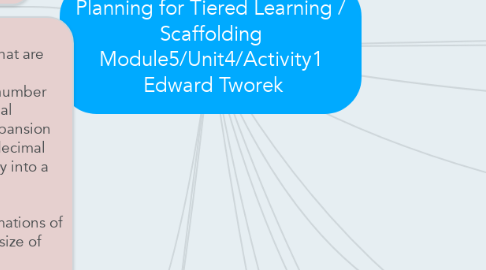Planning for Tiered Learning / Scaffolding Module5/Unit4/Activity1 Edward Tworek
by Ed Tworek

1. Standards Addressed: MCC8.NS.1: Know that numbers that are not rational are called irrational. Understand informally that every number has a decimal expansion; for rational numbers show that the decimal expansion repeats eventually, and convert a decimal expansion which repeats eventually into a rational number. MCC8.NS.2: Use rational approximations of irrational numbers to compare the size of irrational numbers, locate them approximately on a number line diagram, and estimate the value of expressions (e.g., π2). For example, by truncating the decimal expansion of √2 (square root of 2), show that √2 is between 1 and 2, then between 1.4 and 1.5,and explain how to continue on to get better approximations.
2. Math Grade Level 8 - Algebra
3. 1. Pre-Teach Vocabulary: Each Math Lesson has unique, key vocabulary associated with the topic. Students will be asked to study and learn key words such as: Decimal Expansion: The decimal expansion of a number is its representation in base 10 (i.e., the decimal system). For example, the decimal expansion of 25 squared is 625, of π Is 3.14159..., and of 1/9 is 0.1111.... Integer: The set of whole numbers and their opposites. Irrational: A real number whose decimal form is non-terminating and non-repeating that cannot be written as the ratio of two integers. Perfect Square: A number that has a rational number as its square root. Radical: A symbol that is used to indicate square roots. Rational: A number that can be written as the ratio of two integers with a non-zero denominator. Square Root: One of two equal factors of a nonnegative number. For example, 5 is a square root of 25 because 5•5 = 25. Another square root of 25 is - 5 because (-5)•(-5) = 25. The +5 is called the principle square root of 25 and is always assumed when the radical symbol is used. By introducing the "lingo" of math early in the lesson, students should be less intimidated by the lesson.
4. Key Factors about the Students - (Prior knowledge about the topic or readiness level): The Scaffolding strategies selected should lend themselves well to a highly diverse classroom environment where some students are from affluent families while others are from lower income environments at home. The students that have a more accelerated learning background are provided the opportunity to take a leadership position in engaging their peers for mentoring and assistance. Those in the class that have an IEP are better motivated and focused when they are able to work in groups and teams. In addition, the frequent use of formative assessments by allowing students to talk out loud with questions and answers to problems will keep them all equally engaged as much as possible. Finally, use of visuals and every day / real life show and tell examples of the math lesson enables clear understanding and conceptual grasping of what fractions, decimals, rational & irrational numbers are and how their magnitudes relate to each other on a number line or via other geometric shapes. The ultimate goal is to teach the students to appreciate the process of learning so that they are motivated to do self-study throughout their lives.
5. Two Objectives to be Met Related to these Common Core Standards
6. 1. Students will be able to convert Fractions to Decimals using the division of Numerator by Denominator Method.
7. 2. Students willl be able to use a number line to place fractions in their corresponding place based upon magnitude relationships to whole numbers.
8. Big Ideas that Students should Know to Meet the Standard
9. 1. Learn to write a decimal approximation for a fraction to a given decimal place. How can any fraction be converted and represented in decimal format.
10. 2. Learn to place fraction representations of rational and irrational numbers on a number line. Why is it important to be able to graphically depict relative magnitude or rational and irrational numbers?
11. Scaffolding Strategies to Meet Objectives
12. 2. Tap into Prior Knowledge: Give students a Pre-Assessment Quiz that enable them to "jog their memory" of previous lessons leading up to this one. Also, use frequent assessments throughout the lesson to determine if students are grasping the "chunks" of topic learning covered. Games and internet web sites can be utilized for this strategy to make it more fun and less stressful.
13. 3. Teacher, Class, Group, Individual Does It: Progressively work towards an individual student being able to solve fraction conversion and number line placement exercises by first showing the method then allowing them to work together and finally solving problems alone.
14. 4. Show & Tell: Use real life examples of fraction to decimal relationships via puzzles and games that depict the relative magnitude of rational & irrational numbers. Start simple and then move to more complex situations like starting with linear / line examples and then moving to 2D circular and the 3D solid objects to depict parts of the whole.
15. 5. Use Visual Aids: Especially with Math - visualizing solutions to problems is a key way for anyone to thoroughly grasp the topic objectives. Use of Pie Charts, Number Lines, Stacked Bar Charts, and various Geometric Shapes will greatly assist in getting students to understand fractions, decimals, and respective relative magnitudes.
16. 6. Pause, Ask Questions, Pause, Review: Here's how this strategy works. A new idea from discussion or the reading is shared, then pause (providing think time), then ask a strategic question, pausing again. Keep students engaged as active listeners by calling on someone to "give the gist" of what was just discussed / discovered / questioned. If the class seems stuck by the questions, provide an opportunity for students to discuss it within small groups or learning buddies. This strategy not only enhances student interest in math but provides frequent formative assessment of learning progress throughout the lesson planned.


